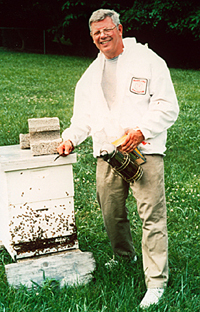|
June 26, 2002--Teaching others about beekeeping has long been a way of life for Dewey Caron, professor of apiculture at the University of Delaware College of Agriculture and Natural Resources. Caron’s latest book, “Africanized Honey Bees in the Americas,” may well have a popular appeal unmatched by anything else he has written. That’s because Africanized bees have the reputation for being “killer bees”—a reputation Caron wants to challenge or at least to quantify.
 |
| Dewey Caron posing in a local apiary with a colony of gentle honey bees. These bees trace their genetic roots to Italy and Germany. The colonists carried bees to America from Europe in the early 17th century. |
“The first thing people want to know when they learn I am a beekeeper is whether I have any so called ‘killer bees,’” Caron said, noting that what he refers to as Africanized bees have been sensationalized by the popular press so much that everyone has heard about them, is fearful of them and is anxious for information.
While the bees haven’t arrived in Delaware yet, Caron first became acquainted with them 20 years ago in Panama and has worked with them continuously ever since in development work he has done throughout Latin America. This book is a result of that association.
It is an attempt to sort fact from fiction and to paint a true portrait of these honey bees that Caron says are here to stay.
Bee background
According to Caron, honey bees are indispensable pollinators, essential to agriculture and to the production of more than 100 fruits and vegetables. The gentle, European honey bees that make their homes in the Americas were carried over by colonists hundreds of years ago, and later taken to Latin America. In 1956, a geneticist from Brazil set out to improve his stock of Brazilian bees by breeding them with a population of bees he had carried from the tropical areas of Africa, expecting that they would be better suited genetically to the tropical conditions in Brazil than those whose origins had been Italy and Germany.
“The African bees were exceptional producers in parts of their native Africa,” says Caron, “so outstanding that they held the world record for honey production, which earned them a place of honor in Ripley’s Believe It Or Not.
“The African bee, however, is very defensive,” says Caron. “In other words, it has one good trait and one bad trait.”
The plan was to initiate a honey bee breeding program that would result in a new bee, productive like the African bee but gentle like the European bee. The newcomers, however, escaped before the program got under way. And, when they mixed with the feral population of gentle European bees, the unexpected happened again in that the African bee genetic material was not diluted as anticipated. Instead, the gentle bees become Africanized in their behavior taking on a more defensive demeanor. This biological turnover of genetic material happened quickly, too, especially in the tropics.
Caron explains that accidental releases are not unusual and what usually happens is that species perish or do not reproduce because they are not adapted to the new area. Only one in a thousand becomes a problem.
“The Africanized bees adapted so well, however, that they spread rapidly on their own.”
Bee book
With dozens of pages of references, “Africanized Honey Bees in the Americas” is as scientific a resource as any, but it is much more besides. It’s chocked full of curious research about bee biology. For example, there is the story that links the defensive behavior of Africanized bees with their environment or, more precisely, with elevation. In an extraordinary series of studies in Bolivia, Caron carried the same queen bees up and down the mountains of that country to observe the behavior of their progeny—the female worker bees—in each location. Depending on elevation, he found that bees had a personality reversal within about five to six weeks.
“We notice it in a month,” he said, “and the change is apparent whether going from higher elevations to the tropical lowlands, or the other way around. The same bees that are defensive in the lowlands are much easier to handle in the mountains.”
The book also is rich in human interest stories that tell tale after tale of how people in different countries triumph over adversity, actually profiting from the uniqueness of the Africanized bees. In some countries, Caron points out, beekeepers not only harvest honey but, because these bees carry more pollen than European bees, they put a wire grid on the front of their colony to collect pollen. Pollen is sold for all sorts of medicinal uses in some countries.
“The Africanized bee is a most unique phenomenon,” Caron concludes. “It is not all good, nor is it all bad. It has caused some problems for beekeepers, some real tragedies for families of victims and economic hardship for beekeepers and others whose lives have been touched by this population of bees. It has also become a resource for the rural poor to rob for honey and beeswax.
“The bees—now established in six states (Texas west to California) and expected to colonize the southeastern United States in the next decade—will not go away. We need to learn to better live with them.
“This book is dedicated to that goal.”
|

